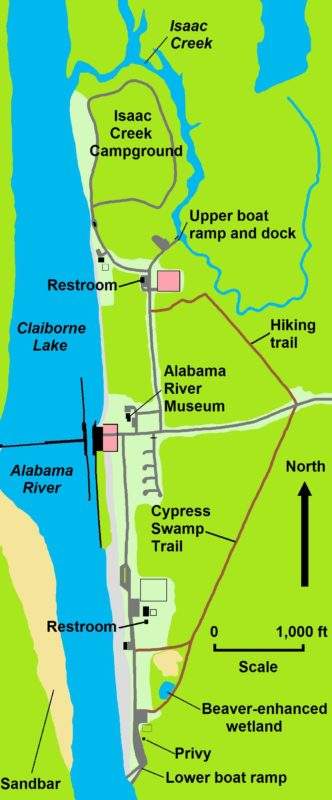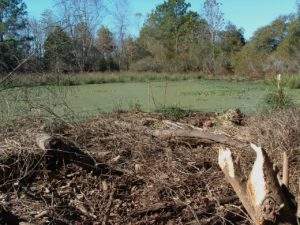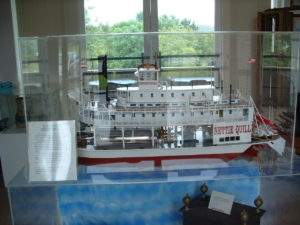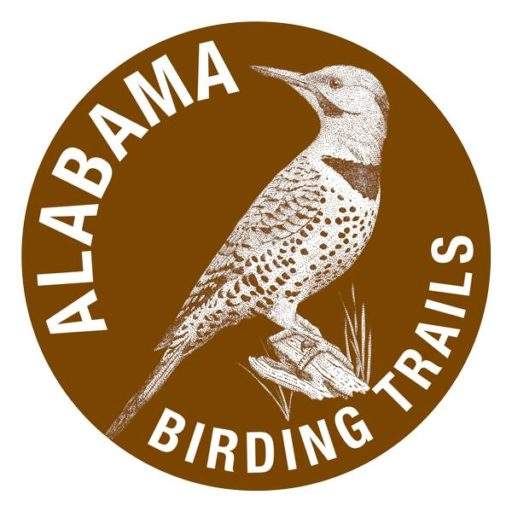
By Don and Judy Self
The Claiborne Dam Site East Park US Corps of Engineers facility is one of the few places on the Piney Woods Birding Trail that has it all. In addition to its variety of habitats, it is the take-out for paddles from the Corps of Engineers Parks located upriver (PWBT stops 8, 11 and 13). The Alabama River Canoe Trail portage extends through the Dam Site East Park from the upper boat ramp to the lower boat ramp. Isaac Creek Campground provides 60 campsites, all with water and electrical hookups, in a hardwood grove between Claiborne Lake and Isaac Creek. And the Alabama River Museum offers exhibits and hands-on displays for young and old alike.
Directions: From the intersection of US Highway 84 (mile marker 64.2) and Monroe County Road 39 at Claiborne, take Monroe 39 north 8.3 miles to Alabama Highway 41, turn left (north) on Alabama 41 and go 0.7 miles, turn left (west) on Monroe 17 and go 5.0 miles, turn left (west) on Monroe County Road 44 (Lock & Dam Road) and go 1.4 miles, turn left on Monroe 13 (Lock & Dam Road) and go 3.6 miles to the park entrance (note that there’s a nasty zigzag at the 2.5 mile mark, please slow down for it).
Description: This 500-acre park contains a variety of habitats. The area near the entrance is loblolly pine plantation; park at the Alabama River Museum and bird the edges of the pines. Summer Tanagers, Pine Warblers, Indigo Buntings and Eastern Bluebirds are spring and summer regulars. Purple Martins, Northern Rough-winged and Barn Swallows and Orchard Orioles frequent the area around the museum. Wild Turkey, Northern Mockingbird and Pine Warbler are year round residents. Watch the lawn areas for the diminutive Common Ground Dove.
Continue north on Isaac Creek Road to the boat ramp on Isaac Creek. Park and bird the hardwood swamp along the creek and the clearing and pines adjacent to the parking area. Canoeing Isaac Creek will greatly enhance the birding experience, but is not a necessity. Green Herons, Mississippi Kites, Acadian Flycatchers and Northern Parulas are spring and summer regulars. Swallow-tailed Kites have been reported nesting north of the Isaac Creek Campground. Winter brings Eastern Phoebes, Yellow-rumped Warblers, Ruby-crowned Kinglets, Purple Finches and several species of sparrows including Swamp Sparrows. During warm weather, alligators are a common sight around the fishing piers.

South of the lock structure, the park consists of lawn and second growth hardwoods. Loggerhead Shrikes regularly nest in the trees adjacent to the road and are year round residents. Park at the pavilion and restrooms or at the overlook parking area and scan the river and west bank for wading birds. Great and Snowy Egrets and Great Blue Herons can be abundant. Osprey and Caspian Terns often fish below the dam during migration and Double-crested Cormorants and Forester’s Terns are regulars in the winter. Watch the large sandbar on the west shore of the river for shorebirds during spring and fall migration.
Continue south to the playground adjacent to the southern boat ramp; park there and walk the Cypress Swamp Trail which follows the top of a dike with pine plantation on the west side and bottomland hardwood and cypress swamp below you on the east. A wetland produced when beavers dammed a culvert is a bird attractant at all seasons; watch for White Ibis, Little Blue Herons and Common Yellowthroats in the spring and summer and a variety of sparrows in winter.

The Alabama River Museum is open on Saturday from 9:00 am until 4:00 pm, March through October. The museum’s exhibits include Eocene marine fossils from the bluffs at Claiborne and Bell’s Landings that brought fame and world renowned paleontologists to the area in the early 1800’s. Dr. Timothy Conrad of Philadelphia spent almost two years studying and collecting at Claiborne. There are Native American artifacts excavated at the present Claiborne Lock and Dam site and other archaeological sites in Monroe County that span thousands of years from pre-history to the Creek Indians who lived in Monroe County until the Removal of 1834, better known as the Trail of Tears.
And exhibits that immortalize the steamboat era of transportation include a working scale model of the Nettie Quill, a steamboat that traveled the Alabama River. The region’s wildlife also figures prominently in the museum’s displays and there are a number of hands-on activities for young people. For information, contact: the Monroe County Heritage Museums, P.O. Box 1637, Monroeville, AL 36461, and phone: 251-575-7433 or go to “www.tokillamockingbird.com.”
Access: Free; please note that parts of the park are open to hunting during hunting seasons.
GPS Coordinates: N 31° 36.960’ / W 87° 32.445’ (Park entrance)
Contact: US Army Corps of Engineers
1226 Power House Road
Camden, AL 36726
Phone: 334-682-4244
Amenities: Restrooms, Handicap access, Potable water, Parking, Camping (Isaac Creek Campground is part of this facility and is open year round; it has RV hook-ups, showers, laundry, and potable water), Canoeing, Boat access, Picnic area, Hiking
